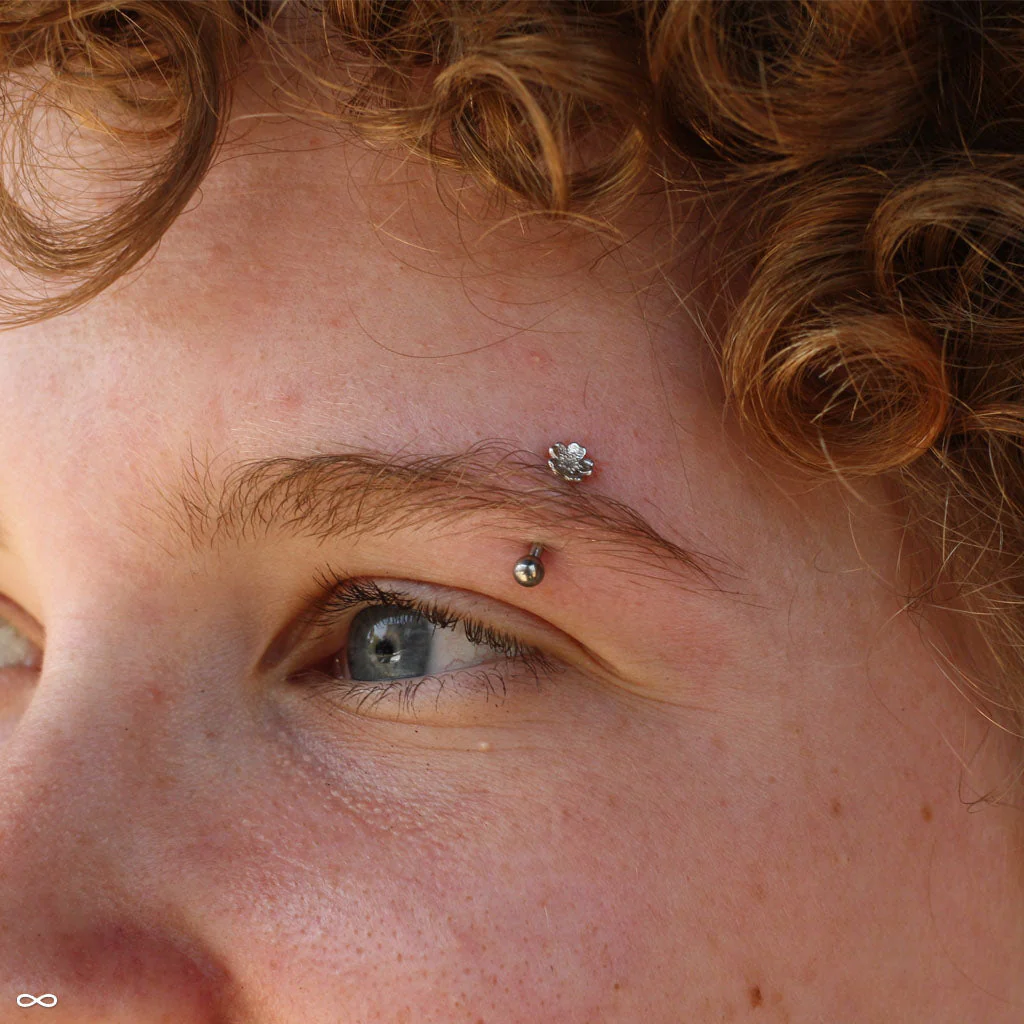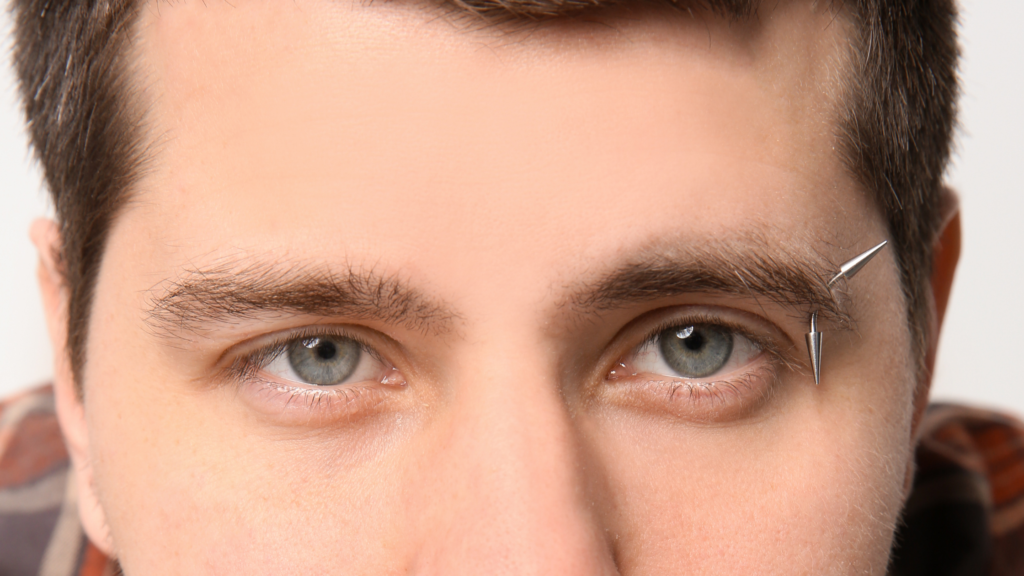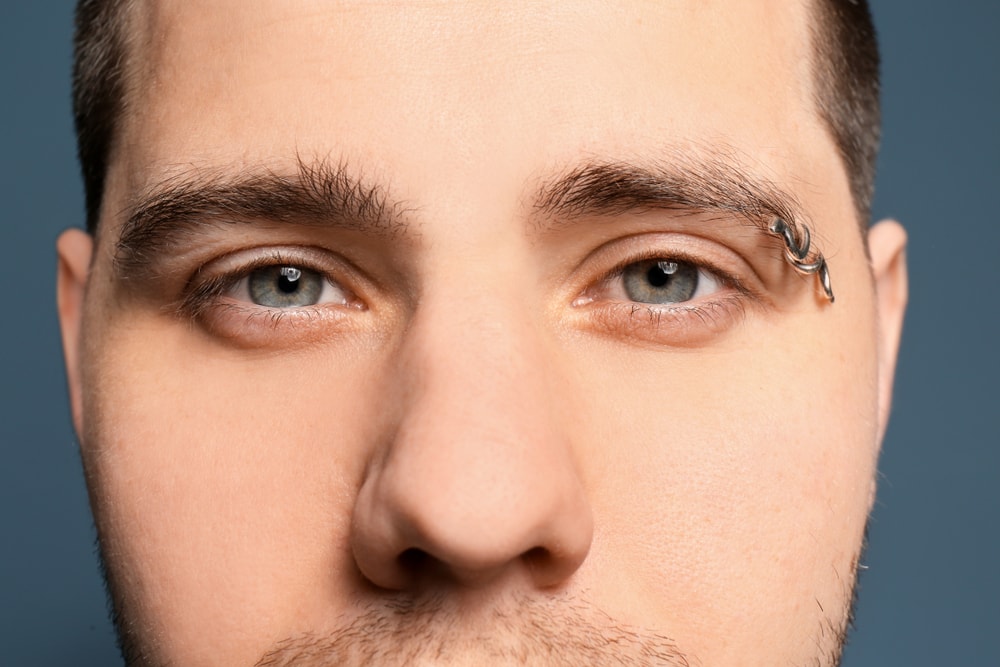The longevity of an eyebrow piercing can differ from one individual to another, but on average, it typically lasts between 3 months to 2 years, or even longer with proper care. Several factors come into play when determining how long your eyebrow piercing will last.
Firstly, everyone’s body is different, and healing times can vary. Some people may experience a faster healing process, while others might take more time.
Secondly, how well you take care of your piercing plays a crucial role. Following aftercare instructions provided by your piercer, keeping the area clean, and avoiding irritants can help extend the life of your piercing.
Lastly, the type of jewelry you use can impact its longevity. High-quality, hypoallergenic materials are less likely to cause complications and can help your piercing last longer.
What Is An Eyebrow Piercing?

An eyebrow piercing is a form of body piercing where a small hole is created through the eyebrow, typically positioned horizontally along the brow ridge. A piece of jewelry, often in the form of a small barbell or a curved bar, is then inserted through this hole, allowing it to pass through the eyebrow.
Eyebrow piercings are a popular form of body modification and self-expression. They can be placed at various positions along the eyebrow, depending on personal preference and aesthetics. Some people choose to have a single eyebrow piercing, while others opt for multiple piercings in a row, creating a more dramatic look.
What Are Types of Eyebrow Piercings?
There are several types of eyebrow piercings, each with its unique style and placement. Here are some of the most common types of eyebrow piercings
Horizontal Eyebrow Piercing
Horizontal eyebrow piercings are a classic choice that involve placing a single piercing horizontally through the eyebrow, usually above the brow ridge. This style offers versatility in terms of jewelry options, allowing individuals to express their unique style.
Whether adorned with a sleek barbell, a chic hoop, or a decorative stud, horizontal eyebrow piercings can be customized to suit various aesthetics, making them a popular choice among those seeking an eye-catching yet timeless look.
Vertical Eyebrow Piercing
Vertical eyebrow piercings take a creative twist on traditional eyebrow piercings by running the jewelry vertically through the eyebrow. This unique placement involves one end of the jewelry positioned above the eyebrow, while the other sits below it.
The result is an edgy and unconventional appearance that can be further enhanced with stylish jewelry options, making it a favorite among those looking to make a bold fashion statement.
Anti-Eyebrow Piercing
Also known as a teardrop piercing, the anti-eyebrow piercing is an unconventional choice that involves piercing the skin just below the eye. This creates a subtle teardrop shape and places the jewelry on the cheekbone.
The result is a distinct and eye-catching look that complements facial features while adding a touch of avant-garde style. Anti-eyebrow piercings often utilize dainty studs or gem-adorned jewelry for a subtle yet captivating effect.
Spiral Eyebrow Piercing
For those who appreciate artistic and customized piercings, the spiral eyebrow piercing is an ideal choice. This style features multiple piercings along the eyebrow, often arranged in a curved or spiral pattern.
The jewelry arrangement can be tailored to create intricate and captivating designs, allowing individuals to showcase their creativity and individuality through their piercings.
T-Bar Eyebrow Piercing
T-bar eyebrow piercings are a unique variation of the classic horizontal eyebrow piercing. They involve two separate piercings on the same eyebrow, connected by a single piece of jewelry that forms a “T” shape. This style creates a striking and unconventional look that draws attention to the brow area. T-bar eyebrow piercings offer a blend of symmetry and asymmetry, making them a compelling choice for those seeking a distinctive aesthetic.
Bridge Piercing
While not strictly an eyebrow piercing, the bridge piercing is placed horizontally across the bridge of the nose, often just above the base of the nose. This piercing creates an illusion of an eyebrow piercing from a distance, adding an element of intrigue to one’s appearance.
Bridge piercings can be adorned with elegant jewelry, making them a stylish and attention-grabbing option for those looking to enhance their facial features.
Surface Eyebrow Piercing
Surface eyebrow piercings are known for their aesthetic appeal and involve piercing the skin along the surface of the eyebrow. Unlike traditional piercings that go through the eyebrow, surface piercings are placed on the skin’s surface and can be positioned at various angles.
This style offers a unique and captivating look that highlights the eyebrow’s contour, allowing for artistic and creative jewelry placements.
Double Eyebrow Piercing
Double eyebrow piercings are a bold choice that involves placing two separate piercings on the same eyebrow, usually in a horizontal orientation. This creates a symmetrical and attention-grabbing look that accentuates the brow area.
Whether adorned with matching jewelry or complementary pieces, double eyebrow piercings add a captivating and balanced touch to one’s facial aesthetics.
Triple Eyebrow Piercing
Building on the concept of multiple piercings, triple eyebrow piercings take it a step further by incorporating three separate piercings on the same eyebrow. The jewelry is strategically placed to create a visually appealing composition that draws attention to the brow area. This style allows for intricate and personalized jewelry arrangements, making it a favored choice among those seeking a captivating and unique appearance through their piercings.
What Are The Signs Of A Well-Healed Eyebrow Piercing
A well-healed eyebrow piercing should exhibit several characteristics that indicate a successful and healthy healing process. Here are the signs to look for
Minimal Discomfort: A healed eyebrow piercing should no longer be painful or tender to the touch. Any initial soreness or discomfort should have subsided, and you should be able to touch the area without pain.
Reduced Swelling and Redness: In the initial days after getting an eyebrow piercing, some swelling and redness are normal. However, a well-healed piercing will show a significant reduction in these symptoms. The area should appear calm, with little to no redness or swelling.
Proper Placement: The piercing should still be in its original placement, without any signs of migration or rejection. Migration is when the piercing slowly moves away from its initial position, while rejection is when the body pushes the jewelry out. A well-healed piercing will maintain its proper placement.
No Discharge or Crustiness: During the healing process, it’s common to experience some discharge or crustiness around the piercing site. This is the body’s natural way of expelling debris and promoting healing. In a well-healed piercing, this discharge should have stopped, and the area should be clean.
Ease of Movement: You should be able to move the jewelry without any discomfort or resistance. A healed eyebrow piercing allows for the smooth movement of the jewelry without tugging or pain.
Lack of Infection Signs: Signs of infection, such as persistent redness, swelling, warmth, pus, or a foul odor, should be absent in a well-healed piercing. If any of these symptoms persist, it’s essential to seek professional medical advice.
Steady Jewelry: The jewelry should be firmly in place, and there should be no signs of it becoming loose or unscrewing on its own.
Normal Skin Color: The skin around the piercing should have returned to its normal color, without any excessive redness or discoloration.
It’s important to note that the healing time for eyebrow piercings can vary from person to person, but it typically takes several weeks to a few months.
During this period, proper aftercare is essential to ensure a smooth healing process. If you notice any signs of infection, migration, or other issues, it’s crucial to consult with a professional piercer or a healthcare provider for guidance and appropriate treatment.
What Are The Risks of Eyebrow Piercings?
Eyebrow piercings, like any form of body modification, come with certain risks and potential complications. It’s important to be aware of these risks before getting an eyebrow piercing.
Infection
Infections are one of the most common risks associated with piercings, including eyebrow piercings. These infections can occur if the piercing site is exposed to bacteria or if proper aftercare practices are not followed diligently.
However, Signs of infection may include redness, swelling, warmth, discharge, and pain. In severe cases, untreated infections can lead to abscess formation or even systemic complications.
Keloids or Hypertrophic Scarring
Some individuals are predisposed to developing keloids or hypertrophic scars, which are raised, thickened, and often itchy areas of scar tissue. These can form at the site of the piercing, particularly if there is a history of keloid scarring in the family. While not common, they can be challenging to manage and may require additional medical treatment.
Migration and Rejection
Eyebrow piercings are prone to migration, which occurs when the piercing gradually moves away from its initial placement, and rejection, where the body pushes the jewelry out entirely. Migration and rejection are more likely to happen if the piercing is placed too shallowly, the jewelry is of poor quality, or if there is frequent trauma or movement to the piercing site. This can result in the loss of the piercing.
Allergic Reactions
Some individuals may be allergic to specific metals used in piercing jewelry, such as nickel. Allergic reactions can manifest as redness, itching, and irritation around the piercing site. Choosing hypoallergenic materials like surgical steel, titanium, or niobium can help prevent this issue.
Damage to Surrounding Tissue
If the piercing is not performed correctly, or if there is excessive movement or trauma to the jewelry during the healing process, it can damage surrounding tissue or nerves. This can lead to discomfort, prolonged healing times, or the need for corrective procedures.
Scarring
Scarring is a natural part of the body’s healing process, but excessive scarring or the formation of unsightly keloids can be a risk with any piercing. Scarring can affect the appearance of the eyebrow area and may be permanent.
Eyebrow Hair Issues
The presence of jewelry in the eyebrow area can potentially lead to problems with eyebrow hair. Hair may become entangled with the jewelry, leading to discomfort or hair loss around the piercing. It’s essential to be mindful of this and consider jewelry styles that minimize hair interference.
Eye Injury
While rare, there is a risk of eye injury if the jewelry is too long or improperly placed. It’s crucial to ensure that the piercing is done by a trained and experienced professional who understands the anatomy of the eye and surrounding tissues to minimize this risk.
To reduce these risks, it’s essential to
- Choose a reputable and experienced piercer.
- Follow proper aftercare instructions provided by your piercer.
- Keep the piercing clean and avoid touching it with dirty hands.
- Use high-quality, hypoallergenic jewelry.
- Avoid excessive movement or trauma to the piercing.
- Monitor the piercing for any signs of infection or complications and seek professional advice if any issues arise.
EYEBROW PIERCING HEALING TIME

The healing time for an eyebrow piercing can vary from person to person, but on average, it takes several weeks to a few months for the piercing to fully heal. Here’s a more detailed breakdown of the eyebrow-piercing healing process
Initial Swelling and Discomfort (Week 1-2)
In the first week or two after getting your eyebrow pierced, you can expect some swelling, redness, and mild discomfort. This is a normal part of the healing process as your body responds to the trauma of the piercing.
Transition to the Healing Phase (Week 2-6)
As the days pass, the initial swelling and redness should begin to subside. During this time, your body is working to form a protective layer of skin around the piercing site. You may notice some crustiness or discharge, which is also normal as your body expels any debris from the wound.
Reduced Sensitivity (Week 6-8)
By the sixth to eighth week, the piercing site should start feeling less sensitive. However, it’s crucial to continue following proper aftercare during this phase to avoid complications.
Solidification of Healing (Months 2-6)
Over the next few months, the healing process continues, and the tissue around the piercing site strengthens. This is the stage where the piercing becomes more stable and less prone to complications.
Full Healing (Months 6-12)
By the sixth to twelfth month, the eyebrow piercing should be fully healed. At this point, you should experience minimal to no discomfort, swelling, or discharge. The piercing is stable, and you can confidently change the jewelry if desired.
It’s important to note that individual healing times can vary due to factors like your overall health, genetics, and how well you follow aftercare instructions.
Proper aftercare, which typically involves cleaning the piercing with a saline solution and avoiding irritants like makeup or excessive touching, is essential to ensure a smooth healing process.
During the healing period, it’s crucial to be patient and avoid changing the jewelry too soon, as this can disrupt the healing process and lead to complications. If you experience any signs of infection or unusual issues, it’s essential to seek advice from a professional piercer or a healthcare provider promptly.
FAQ
Do eyebrow-piercing holes go away?
Eyebrow-piercing holes can gradually close up over time, but they may leave a small scar or mark. Whether they disappear entirely varies from person to person.
Do eyebrow piercings reject over time?
Eyebrow piercings can reject over time if the body pushes the jewelry out. This risk is minimized with proper care and high-quality jewelry.
What’s the most painful piercing?
The pain level of a piercing is subjective, but some consider cartilage piercings, like the helix, to be among the most painful due to the density of cartilage.
Are eyebrow piercings a bad idea?
Eyebrow piercings aren’t inherently a bad idea, but they require proper care and consideration. They carry the usual risks associated with piercings.
What is a butterfly kiss piercing?
A butterfly kiss piercing typically refers to a variation of an anti-eyebrow piercing, where the jewelry sits below the eye rather than on the eyebrow.
Do eyebrow piercings leave a mark?
Eyebrow piercings can leave a small mark or scar when removed, but it’s usually minimal and can fade over time.
How painful is an eyebrow piercing?
The pain of an eyebrow piercing is generally moderate and brief. Pain perception varies among individuals, but it’s usually tolerable.
What is the hardest piercing to heal?
The hardest piercing to heal can vary, but cartilage piercings, like the industrial or helix, often have longer healing times and require careful aftercare.
Can I touch my eyebrow piercing?
Avoid touching your eyebrow piercing as much as possible during the healing process to prevent infection and irritation.
Should I pierce my left or right eyebrow?
The choice between left or right eyebrow piercing is a personal preference. You can choose the side that feels more comfortable and suits your style.
Final words
The lifespan of an eyebrow piercing can be as unique as the individual wearing it. It’s a journey that varies from person to person, influenced by factors like aftercare, jewelry quality, and personal choices.
For some, an eyebrow piercing may be a short-term venture, a temporary sparkle that adds excitement to special moments. For others, it’s a long-term commitment, a style statement that becomes part of who they are.
The key to a successful eyebrow piercing experience lies in understanding your own goals and managing your expectations. Whether you embrace it for a short or long duration, proper aftercare is vital to keep your piercing healthy and happy.
And remember, there may come a time when your piercing tells you it’s ready to retire. Recognizing the signs and safely removing the jewelry ensures a graceful exit.

